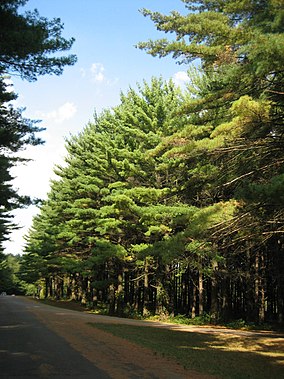White Pines Forest State Park
| White Pines Forest State Park | |
|---|---|
IUCN category V (protected landscape/seascape)[1] | |
 A portion of the southernmost stand of native white pines (Pinus strobus) in Illinois. | |
| Location | Ogle, Illinois, United States |
| Coordinates | 41°59′44″N 89°28′07″W / 41.99556°N 89.46861°W |
| Area | 385 acres (156 ha) |
| Elevation | 722 ft (220 m)[2] |
| Established | 1927 |
| Named for | native white pines |
| Visitors | 350,000+ |
| Governing body | Illinois Department of Natural Resources |
| Website | White Pines Forest State Park |
White Pines Forest State Park, more commonly referred to as White Pines State Park, is an
The area was poised to become a state park in 1903, but a
History
Early history
White Pines Forest State Park is located in what was once a part of the

The influential Friends of Our Native Landscape included the area around the Rock River between
The Illinois Board of State Park Advisers was established under a 1925 state law. The law, which was amended in 1931, gave the director of the
Lodge and cabins
In 1933, with the

After the lodge was completed, it was decided to build a
Nature Preserve designation
In September 2001 the
Description
White Pines State Park is a 385-acre (156 ha) state park located in the heart of the
Among the park's most distinctive and well-known features are the vehicular river crossings. At three places, crossing Pine Creek, fords were constructed instead of bridges.[5] The fords offer visitors a chance to actually drive through the creek, though high water frequently closes the crossings.[5][9] Hikers are relegated to pedestrian bridges or stepping stones in the creek to cross the stream.[10] Floods are frequent enough on Pine Creek, a large watershed to the north of the park, that there is an emergency exit from the campground. When high water closes the fords, the campground is cut off and the emergency exit is the only way out.[5]
Wildlife
The banks of
Activities
The park, Illinois' third oldest, has become one of the state's most visited parks, hosting over 350,000 visitors each year.[10] It was visited by 10,000 people on given weekends during the 1930s, and the 1958 record-setting attendance mark was documented at 874,000.[5]

The park is a public area and has a variety of activities that are typically associated with protected areas meant to be visited by the public. During the warmer months, picnicking, camping, lodging, hiking, and fishing are available. During the winter, cross-country skiing trails open, and other activities such as camping remain available as well.[9][10] The lodge and cabins are listed on the U.S. National Register of Historic Places.[7][13] The 25 cabins are operated by a privately owned entity, the White Pines Inn, and the lodge features a popular private restaurant.[10]
White Pines has 103 campsites all accessible by vehicle; the
See also
Notes
- ^ a b Protected Planet. "White Pines Forest Nature Preserve". United Nations Environment World Conservation Monitoring Centre. Retrieved December 26, 2018.
- ^ "White Pines Forest State Park". Geographic Names Information System. United States Geological Survey. September 30, 1999. Retrieved June 13, 2008.
- ^ a b c d e f "Conserving the Land: The Rock River Country," Critical Trends Assessment Program, Rock River Country Project ([1]), Illinois Department of Natural Resources, Retrieved on May 27, 2009.
- ^ a b c Illinois State Park Lodges and Cabins Thematic Resources, National Register of Historic Places Inventory Nomination Form (PDF), National Register Information System Database, National Register of Historic Places, National Park Service. Retrieved July 2, 2007.
- ^ a b c d e f g h i j k l Pensoneau, Liz. Yule Love It, Outdoor Illinois, December 2001, Northern Illinois University, Illinois Periodicals Online. Retrieved July 2, 2007.
- ^ Department of Conservation, Record Group 244.000, Illinois Archives, Illinois Secretary of State. Retrieved July 2, 2007.
- ^ a b White Pines State Park Lodge and Cabins, (PDF), Individual Property Form, HAARGIS Database, Illinois Historic Preservation Agency. Retrieved July 2, 2007.
- ^ a b c "Up Front," Outdoor Illinois, September 2001, Vol. IX, No. 9. Retrieved July 3, 2007.
- ^ a b c d e f g h White Pines Forest State Park Archived 2006-12-05 at the Wayback Machine, Illinois Department of Natural Resources, official site. Retrieved July 2, 2007.
- ^ a b c d e Davenport, Don. "Getting away to it all at White Pines park," Chicago Tribune, June 10, 2001. Retrieved July 3, 2007.
- ^ "White Pines State Park," Weekly Fishing Reports, ifishillinois.org, Illinois Department of Natural Resources. Retrieved May 27, 2009.
- Press Release), March 15, 2007, Illinois Department of Natural Resources. Retrieved July 3, 2007.
- ^ "National Register Information System". National Register of Historic Places. National Park Service. July 9, 2010.
External links
- State park guide
- "White Pines Forest State Park". Illinois Department of Natural Resources. Retrieved July 20, 2018.

